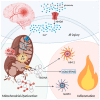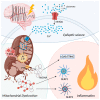The Dichotomous Role of Inflammation in the CNS: A Mitochondrial Point of View
- PMID: 33066071
- PMCID: PMC7600410
- DOI: 10.3390/biom10101437
The Dichotomous Role of Inflammation in the CNS: A Mitochondrial Point of View
Abstract
Innate immune response is one of our primary defenses against pathogens infection, although, if dysregulated, it represents the leading cause of chronic tissue inflammation. This dualism is even more present in the central nervous system, where neuroinflammation is both important for the activation of reparatory mechanisms and, at the same time, leads to the release of detrimental factors that induce neurons loss. Key players in modulating the neuroinflammatory response are mitochondria. Indeed, they are responsible for a variety of cell mechanisms that control tissue homeostasis, such as autophagy, apoptosis, energy production, and also inflammation. Accordingly, it is widely recognized that mitochondria exert a pivotal role in the development of neurodegenerative diseases, such as multiple sclerosis, Parkinson's and Alzheimer's diseases, as well as in acute brain damage, such in ischemic stroke and epileptic seizures. In this review, we will describe the role of mitochondria molecular signaling in regulating neuroinflammation in central nervous system (CNS) diseases, by focusing on pattern recognition receptors (PRRs) signaling, reactive oxygen species (ROS) production, and mitophagy, giving a hint on the possible therapeutic approaches targeting mitochondrial pathways involved in inflammation.
Keywords: Alzheimer’s disease; Parkinson’s disease; epilepsy; ischemic stroke; mitochondria; multiple sclerosis; neurodegeneration; neuroinflammation.
Conflict of interest statement
The authors declare no conflict of interest.
Figures




References
-
- Barker C.F., Billingham R.E. Immunologically privileged sites. Adv. Immunol. 1977;25:1–54. - PubMed
Publication types
MeSH terms
Grants and funding
LinkOut - more resources
Full Text Sources
Medical

